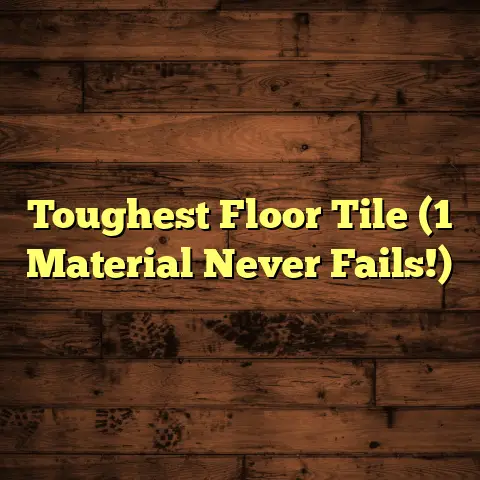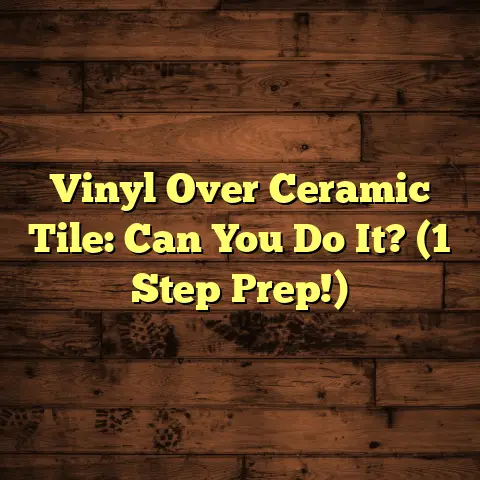Water Under Floorboards? (911 Floor Emergency!)
Ever walked into your home, that sanctuary you’ve poured your heart and soul into, only to be greeted by an unwelcome guest?
Not a burglar, but something far more insidious: the telltale sign of water damage.
Imagine this: you’re padding across your living room, maybe heading for a well-deserved cup of tea.
Suddenly, you hear it… a faint drip… drip… drip.
Your heart sinks. You follow the sound, your senses on high alert.
The air feels heavy, damp. There’s a musty smell you can’t quite place.
Then, you see it: a slight warp in the floorboards, a discoloration that wasn’t there yesterday.
Panic sets in. Water under the floorboards isn’t just a nuisance; it’s a 911 floor emergency!
I’ve seen this scenario play out countless times in my years as a flooring contractor.
And trust me, ignoring it won’t make it go away. It’s like a ticking time bomb, threatening the structural integrity of your home.
The longer you wait, the more damage it will cause, and the more it will cost to fix.
Think mold, rot, and even structural collapse.
That’s why I’m writing this – to arm you with the knowledge to identify, address, and prevent this nightmare scenario.
Let’s dive in and get your home back to being a safe and dry haven.
Section 1: Understanding the Causes of Water Under Floorboards
So, how does this watery menace creep into your home in the first place?
Well, it’s rarely a single cause. It’s usually a combination of factors that create the perfect storm.
Let’s break down the most common culprits I’ve encountered over the years:
-
Leaking Pipes:
This is probably the most frequent offender.
Think about it: a network of pipes snakes through your walls and under your floors, carrying water to every corner of your house.
A tiny pinhole leak, a corroded fitting, or a burst pipe can unleash a torrent of water, often undetected for days or even weeks.
I remember one case where a homeowner had a slow leak under their kitchen sink for months!
They only discovered it when the floorboards started to buckle and emit a foul odor.
By then, the damage was extensive, requiring significant repairs.
According to the EPA, even small leaks can waste significant water annually, contributing to both higher bills and potential damage. * Flooding:
Whether it’s from a torrential downpour, a river overflowing its banks, or a failed sump pump, flooding is a major threat.
Basements are particularly vulnerable, as they sit below ground level and are prone to water infiltration.
I’ve seen homes where entire basements were submerged after a heavy storm, leaving behind a soggy mess and extensive water damage.
The scary part is, even a few inches of floodwater can wreak havoc on your flooring and subfloor.
FEMA provides resources to help homeowners understand flood risks and take preventative measures. * Humidity and Condensation:
High humidity levels, especially in poorly ventilated areas like basements and crawl spaces, can lead to condensation.
This moisture can accumulate on pipes, floors, and walls, creating a breeding ground for mold and rot.
I’ve seen cases where condensation formed on cold water pipes in the summer, dripping onto the subfloor and causing significant damage over time.
Using a dehumidifier and ensuring proper ventilation can help mitigate this issue.
The American Society of Heating, Refrigerating and Air-Conditioning Engineers (ASHRAE) offers guidelines for maintaining optimal humidity levels in buildings. * Appliance Malfunctions:
Washing machines, dishwashers, refrigerators, and water heaters are all potential sources of water leaks.
A leaky hose, a faulty valve, or a malfunctioning pump can release gallons of water into your home before you even realize there’s a problem.
I recall a situation where a washing machine hose burst while the homeowners were away on vacation.
When they returned, they found their laundry room flooded and the water had seeped into the adjacent rooms, causing extensive damage to the flooring.
Regularly inspect your appliances for leaks and replace worn hoses to prevent this from happening.
Energy Star provides resources on energy-efficient appliances, which often include features that can help prevent water leaks.
These are just a few of the common causes of water under floorboards.
The key takeaway is to be vigilant and proactive in identifying potential sources of water damage.
Regularly inspect your plumbing, appliances, and foundation for any signs of leaks or moisture.
A little prevention can go a long way in saving you from a costly and stressful 911 floor emergency.
Section 2: Identifying the Signs of Water Under Floorboards
Okay, so you know the potential causes. But how do you actually detect water lurking beneath your floors?
Here’s a comprehensive guide to the early warning signs I’ve learned to recognize:
-
Visual Cues:
-
Warped or Buckling Floorboards: This is a classic sign of moisture absorption.
The wood expands as it absorbs water, causing it to warp and buckle. * Discoloration: Water stains can appear as dark spots or rings on your flooring.
This is especially noticeable on hardwood floors. * Stains on Walls or Ceilings: If water is seeping up from the floor, it can leave stains on adjacent walls or even the ceiling below. * Visible Mold Growth: Mold thrives in damp environments.
If you see mold growing on your floorboards or walls, it’s a clear indication of moisture problems. * Auditory Signs:
-
Dripping: This is the most obvious sign. If you hear dripping sounds, investigate immediately.
- Gurgling: This sound can indicate a leak in your plumbing system.
- Sloshing: If you hear a sloshing sound when you walk on a particular area of your floor, it means there’s likely water trapped underneath.
-
Odors:
-
Musty Smell: This is a telltale sign of mold and mildew growth.
- Damp Smell: A persistent damp smell in a particular area of your home can indicate a water leak.
-
Increased Humidity:
-
Use a Hygrometer: A hygrometer is a device that measures humidity levels.
If you notice a consistently high humidity level in a particular room, it could indicate a water problem.
Normal indoor humidity should be between 30-50%.
Anything higher than that could be a cause for concern.
According to the Mayo Clinic, high humidity can also exacerbate allergies and respiratory problems.
-
I always tell homeowners to be proactive in their assessments.
Don’t just rely on visual cues. Get down on your hands and knees and inspect your floors closely.
Sniff around for any unusual odors.
Use a flashlight to look for stains or discoloration in dark corners.
If you have a basement or crawl space, check for signs of moisture or leaks.
I recommend investing in a moisture meter.
These devices can detect moisture levels in wood and other materials, helping you pinpoint the source of the leak.
They’re relatively inexpensive and can save you a lot of headaches in the long run.
Remember, early detection is key. The sooner you identify a water leak, the less damage it will cause, and the easier it will be to fix.
Section 3: Immediate Actions to Take
Alright, you’ve discovered water under your floorboards. Don’t panic! Time is of the essence, but a calm, methodical approach is crucial.
Here’s a step-by-step guide to the immediate actions you should take:
-
Shutting Off Water Supply:
- Locate the Main Water Valve: This is usually located near your water meter or where the water line enters your home.
- Turn Off the Valve: Turn the valve clockwise until it’s completely closed.
-
Test the Shutoff: Turn on a faucet to make sure the water has been shut off completely.
If water continues to flow, there may be a problem with the valve itself, and you’ll need to call a plumber immediately. * Removing Floor Coverings:
-
Lift Carpets and Rugs: Remove any carpets or rugs that are covering the affected area.
This will allow the floor to dry more quickly and prevent mold growth. * Remove Damaged Floorboards: If you can safely remove the damaged floorboards, do so.
This will allow you to assess the extent of the damage to the subfloor and facilitate drying.
Be careful when removing floorboards, as they may be brittle and could splinter. * Drying the Area:
-
Use Fans: Place fans around the affected area to circulate air and speed up the drying process.
- Use Dehumidifiers: Dehumidifiers will help remove moisture from the air, preventing mold growth.
-
Use Towels: Use towels to soak up any standing water.
Wring out the towels frequently and replace them with dry ones. * Open Windows: If the weather permits, open windows to ventilate the area. * Documenting Damage:
-
Take Photos: Take photos of the affected area, including the water damage, the source of the leak, and any damaged materials.
-
Keep Records: Keep records of all your expenses related to the water damage, including repairs, replacements, and professional services.
This documentation will be essential when filing an insurance claim.
I can’t stress enough the importance of acting quickly. The longer water sits under your floorboards, the more damage it will cause.
Mold can start to grow within 24-48 hours, and structural damage can occur within days.
Every hour counts!
According to the Institute of Inspection, Cleaning and Restoration Certification (IICRC), proper water damage restoration requires specialized equipment and techniques to ensure that the affected area is completely dry and free of mold.
Don’t hesitate to call a professional water damage restoration company if you’re unsure about how to proceed.
They have the expertise and equipment to handle even the most complex water damage situations.
Section 4: Assessing Damage and Professional Help
You’ve taken the initial steps to mitigate the water damage. Now what?
It’s time to assess the extent of the damage and decide whether you can handle the repairs yourself or if you need to call in the pros.
-
DIY vs. Professional Assessment:
-
DIY Assessment: If the water damage is limited to a small area and you’re comfortable with basic home repairs, you may be able to handle the assessment yourself.
Check the subfloor for signs of rot or structural damage.
Use a moisture meter to check the moisture content of the wood.
If the moisture content is above 16%, the wood is still too wet and needs to be dried further. * Professional Assessment: If the water damage is extensive, or if you’re unsure about how to proceed, it’s best to call in a professional water damage restoration company.
They have the expertise and equipment to conduct a thorough assessment and develop a plan for remediation.
They can also identify hidden sources of moisture and structural damage that you might miss.
-
I’ve seen homeowners try to tackle water damage repairs themselves, only to make the problem worse.
For example, one homeowner tried to dry out a water-damaged subfloor with a space heater.
This caused the wood to warp and crack, requiring even more extensive repairs.
-
Cost Implications:
-
DIY Repairs: The cost of DIY repairs will depend on the extent of the damage and the materials you need to purchase.
You’ll likely need to buy new floorboards, subfloor material, and cleaning supplies. * Professional Repairs: The cost of professional repairs will vary depending on the size of the affected area, the type of flooring, and the extent of the damage.
According to HomeAdvisor, the average cost of water damage restoration is between $3.70-$7.60 per square foot.
This cost can include water extraction, drying, mold remediation, and structural repairs.
-
I always advise homeowners to get multiple quotes from different contractors before making a decision.
Be sure to ask for a detailed breakdown of the costs, including labor, materials, and equipment.
-
Choosing the Right Professionals:
- Check Credentials: Make sure the company is licensed and insured.
- Read Reviews: Check online reviews and ask for references.
- Ask About Experience: Choose a company with experience in water damage restoration.
- Get a Written Estimate: Get a written estimate that includes a detailed description of the work to be performed and the cost.
I recommend looking for companies that are certified by the IICRC.
This certification indicates that the company has met certain standards for training and expertise in water damage restoration.
Don’t be afraid to ask questions. A reputable contractor will be happy to answer your questions and explain the process in detail.
I’ve heard horror stories of homeowners who hired unqualified contractors who did shoddy work and left them with even bigger problems.
Do your research and choose a contractor you can trust to do the job right.
Section 5: Long-term Solutions and Preventative Measures
You’ve dealt with the immediate crisis. Now, let’s focus on preventing this from happening again.
Here are some long-term solutions and preventative measures you can implement to protect your home from future water damage:
-
Waterproofing Techniques:
-
Basement Waterproofing: If you have a basement, consider investing in basement waterproofing.
This can involve sealing cracks in the foundation, installing a sump pump, and applying a waterproof coating to the walls. * Crawl Space Encapsulation: If you have a crawl space, consider encapsulating it with a vapor barrier.
This will prevent moisture from entering the crawl space and causing damage to your flooring. * Regular Maintenance:
-
Inspect Plumbing Regularly: Check your plumbing for leaks on a regular basis.
Pay close attention to areas around sinks, toilets, and water heaters. * Replace Worn Hoses: Replace worn hoses on your washing machine, dishwasher, and refrigerator. * Clean Gutters: Clean your gutters regularly to prevent water from backing up and causing leaks. * Service Appliances: Have your appliances serviced regularly to ensure they’re functioning properly. * Landscaping Solutions:
-
Grade Your Yard: Make sure your yard is graded so that water flows away from your foundation.
- Install Gutters and Downspouts: Install gutters and downspouts to direct rainwater away from your home.
- Plant Trees and Shrubs: Plant trees and shrubs to absorb excess water.
-
Humidity Control:
-
Use Dehumidifiers: Use dehumidifiers in damp areas of your home, such as basements and crawl spaces.
-
Ensure Proper Ventilation: Make sure your home is properly ventilated to prevent moisture buildup.
Install exhaust fans in bathrooms and kitchens to remove excess moisture.
-
I always tell homeowners that prevention is the best medicine.
By taking these steps, you can significantly reduce your risk of water damage and save yourself a lot of money and stress in the long run.
According to the Insurance Information Institute, water damage is one of the most common and costly types of homeowners insurance claims.
Investing in preventative measures can help you avoid these claims and keep your insurance premiums down.
I remember one homeowner who followed my advice and implemented these preventative measures.
A few years later, their neighbor’s house flooded during a heavy storm.
While their neighbor’s house sustained significant water damage, their house remained dry and unscathed.
They were so grateful that they had taken the time to protect their home from water damage.
Conclusion
Water under floorboards is a serious issue that demands immediate attention.
Ignoring it can lead to devastating consequences, including structural damage, mold growth, and costly repairs.
But by staying vigilant, acting quickly, and implementing preventative measures, you can protect your home from this watery threat.
Remember, your home is your sanctuary. It’s where you raise your family, create memories, and find comfort and security.
Safeguarding it from water damage should always be a top priority.
Don’t wait until it’s too late. Take action today to protect your home and your peace of mind.
Be proactive, be informed, and be prepared.
Your home will thank you for it.





